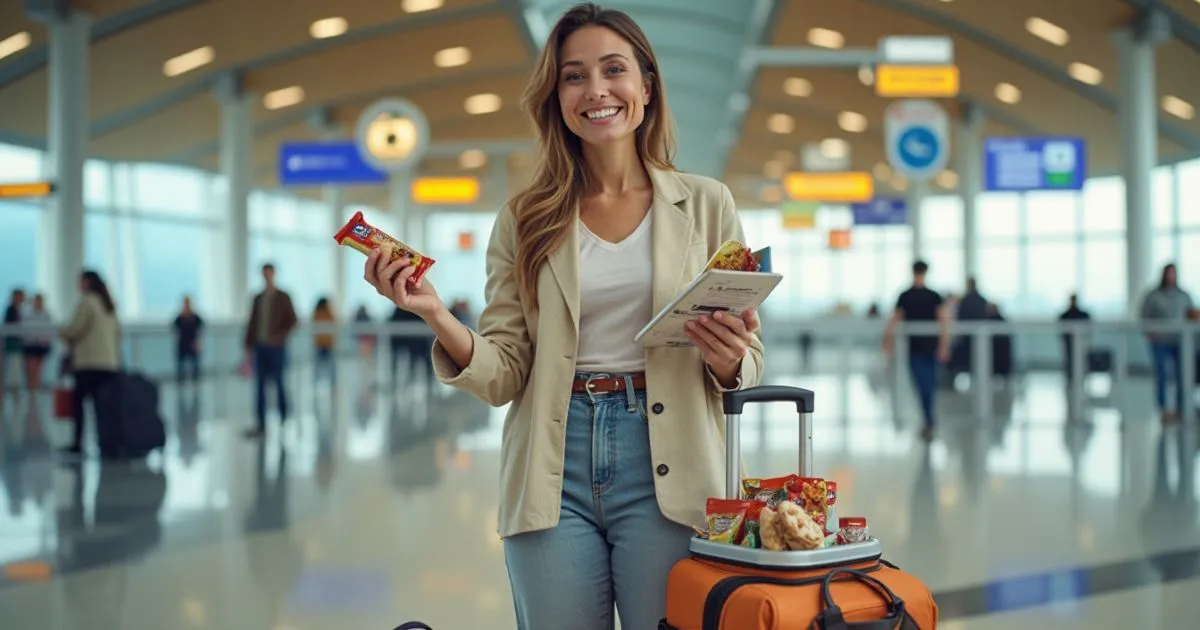Last updated on November 1, 2024
Traveling while maintaining a gluten-free diet can be a challenge, but with the right preparation and knowledge, you can explore the world without compromising your health. Whether you’re planning a road trip, flying across the globe, or just taking a weekend getaway, this guide will provide you with essential tips and tricks to eat gluten-free on the go, ensuring a safe and enjoyable journey.
Table of Contents
Why Gluten Free Traveling Requires Extra Planning
When you’re on the road, gluten-free options may not always be readily available. Cross-contamination, unfamiliar foods, and language barriers can pose risks for those with celiac disease or gluten sensitivity. Proper planning helps you avoid these challenges and ensures you have safe, delicious meals wherever you go.
Pre-Trip Planning: Setting Yourself Up for Success

1. Research Your Destination
- Why: Understanding the gluten-free options available at your destination can help you plan ahead and avoid stress.
- How: Use online resources like gluten free travel blogs, apps, and forums to find gluten-free restaurants and shops. Websites like Find Me Gluten-Free and the Gluten-Free Passport are great tools for locating safe dining spots.
- Tip: Look for accommodations that offer kitchen facilities, allowing you to prepare your own meals if necessary.
2. Pack Gluten-Free Snacks
- Why: Having your own snacks ensures you’re never left without a safe option, especially during long flights, road trips, or in places where gluten-free options are scarce.
- How: Pack non-perishable, portable snacks like gluten-free granola bars, nuts, dried fruit, rice cakes, and gluten-free crackers.
- Tip: If you’re flying, make sure your snacks comply with airline regulations regarding liquids and gels.
3. Bring Essential Gluten Free Supplies
- Why: Certain gluten-free items might be hard to find or unavailable in some locations.
- How: Consider bringing gluten-free bread, pasta, or baking mixes, as well as condiments and seasonings that are guaranteed to be gluten-free.
- Tip: Pack a small cutting board and knife if you plan to prepare your own meals. Consider bringing disposable utensils and wipes to avoid cross-contamination.
Navigating Airports and In-Flight Meals

1. Request a Gluten Free Meal
- Why: Most airlines offer special meals, including gluten-free options, but you need to request them in advance.
- How: When booking your flight, indicate your dietary needs, or contact the airline directly at least 48 hours before departure.
- Tip: Always double-check with the flight crew to ensure the meal provided is gluten-free, as mistakes can happen.
2. Eat Before You Fly
- Why: In-flight meals can be hit or miss, and airport food courts may have limited gluten-free options.
- How: Have a hearty, gluten-free meal before heading to the airport. If your flight is long, pack your own meal in a cooler bag.
- Tip: Many airports now offer gluten-free options, so research ahead of time to find safe dining spots in your departure or layover airport.
Eating Out Safely: Restaurants and Local Cuisine
1. Learn the Local Language (or Key Phrases)
- Why: Communicating your dietary needs is crucial when dining out, especially in non-English speaking countries.
- How: Learn how to say “I have celiac disease,” “I cannot eat gluten,” and “Is this gluten-free?” in the local language. Carry a gluten-free restaurant card in the local language to hand to the waiter.
- Tip: Download translation apps that work offline in case you don’t have internet access.
2. Research Restaurants in Advance
- Why: Not all restaurants are equipped to handle gluten-free requests safely, and cross-contamination can be a concern.
- How: Use apps like Find Me Gluten-Free, Yelp, and TripAdvisor to find restaurants with good reviews from gluten-free diners. Call ahead to ask about their gluten-free options and cross-contamination protocols.
- Tip: Stick to naturally gluten-free cuisines when possible, like grilled meats, vegetables, and rice dishes, but always confirm with the restaurant.
3. Ask the Right Questions
- Why: Even if a dish is labeled gluten-free, it’s important to ask about preparation methods to avoid cross-contamination.
- How: Ask how the dish is prepared, if they use separate cooking utensils and surfaces, and whether they fry gluten-free items in the same oil as gluten-containing foods.
- Tip: Be polite but firm in your questions—your health is the priority.
Staying Gluten-Free on Road Trips
1. Stock Your Car with Essentials

- Why: Road trips often take you through areas with limited food options, and convenience stores rarely have safe gluten-free choices.
- How: Pack a cooler with gluten-free sandwiches, salads, and snacks. Bring along gluten-free bread, deli meats, and fresh fruit for easy meals on the go.
- Tip: If you plan to cook, consider bringing a portable stove or grill along with pots, pans, and cooking utensils.
2. Choose Gluten-Free-Friendly Accommodation
- Why: Staying in places with a kitchenette or kitchen allows you to prepare your own meals, reducing the risk of gluten exposure.
- How: Book hotels or vacation rentals with kitchen facilities through platforms like Airbnb or VRBO. Many hotels also offer mini-fridges and microwaves upon request.
- Tip: Grocery stores and farmer’s markets are your best bet for fresh, gluten-free ingredients.
Managing Cross-Contamination Risks
Cross-contamination is a major concern when eating gluten-free, especially in unfamiliar environments. Here are a few strategies to minimize the risk:
1. Use Gluten-Free Dining Apps
- Apps like Find Me Gluten-Free allow you to read reviews from other gluten free travelers and find trusted restaurants that take cross-contamination seriously.
2. Inspect Your Food
- Even after explaining your needs, double-check your meal when it arrives. Look for signs of gluten-containing ingredients or shared surfaces (like a salad that has croutons removed).
3. Bring Your Own Condiments
- Shared condiment bottles or jars in restaurants or hotels can be a source of gluten contamination. Bring travel-sized gluten-free condiments to use instead.
What to Do in Case of Gluten Exposure

Despite your best efforts, accidental gluten exposure can happen. Here’s how to manage it:
1. Know Your Symptoms
- Understand the signs of gluten exposure and how they manifest in your body. Common symptoms include digestive upset, headaches, fatigue, and skin rashes.
2. Pack a Gluten Emergency Kit
- Include items like digestive enzymes, antacids, pain relievers, and any prescription medications your doctor recommends for managing gluten exposure.
- Tip: Keep your kit in your carry-on or day bag so it’s always accessible.
3. Rest and Recover
- If you do get glutened, rest as much as possible, stay hydrated, and stick to simple, easy-to-digest gluten-free foods until you feel better.
Conclusion
Traveling gluten-free doesn’t have to be stressful. With careful planning, research, and the right tools, you can enjoy your adventures without worrying about gluten exposure. Whether you’re exploring a new city or hiking in the mountains, these tips and tricks will help you stay safe and enjoy your journey. Remember, a little preparation goes a long way in ensuring a smooth and gluten-free travel experience.
Frequently Asked Questions (FAQ)
How do I find gluten-free options in a foreign country?
Use gluten free travel apps, do online research, and connect with local gluten-free communities via social media or forums for recommendations.
Can I trust gluten-free labels in other countries?
Labeling laws vary by country. In some places, “gluten-free” means the product is safe for celiacs, while in others, it may contain trace amounts of gluten. Research the country’s labeling standards and look for internationally recognized gluten-free certification symbols.
How can I avoid gluten at buffets?
Buffets are high-risk for cross-contamination. If possible, avoid buffets entirely, or speak to the chef about preparing a gluten-free meal separately.
What’s the best way to handle airline meals?
Request a gluten-free meal in advance, but also bring your own food as a backup. Airline meals may not always be safe due to cross-contamination or errors.
What should I do if I can’t find gluten-free options?
If you’re in a pinch, stick to naturally gluten-free foods like fruits, vegetables, and plain meats. Carry emergency snacks and consider fasting until you can find a safe option.





This post provides great tips for maintaining a gluten-free diet while traveling, from pre-trip planning to navigating airports and eating out. However, it’s important to also consider safety issues like water contamination, especially in remote areas, and take necessary precautions for both food and water to ensure a safe trip.